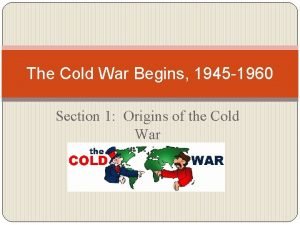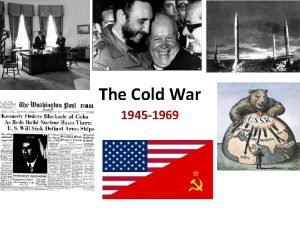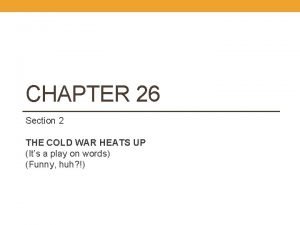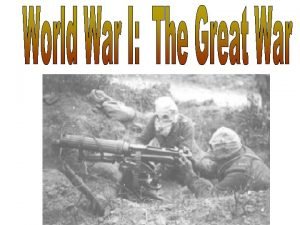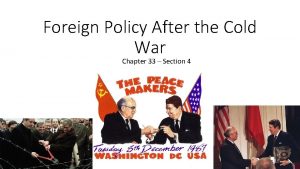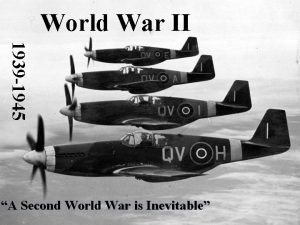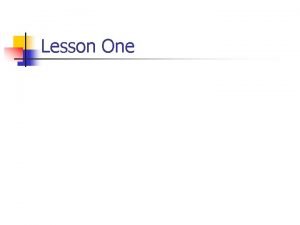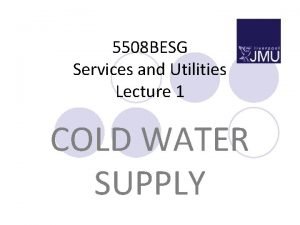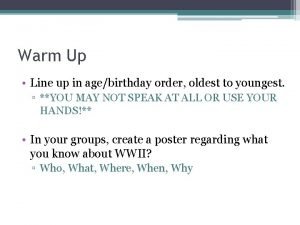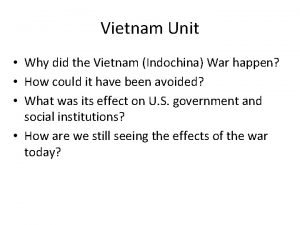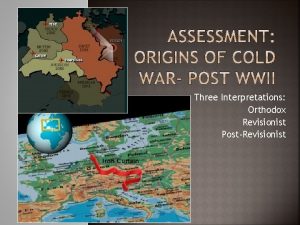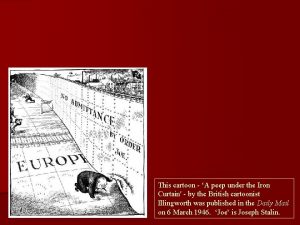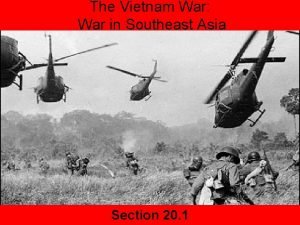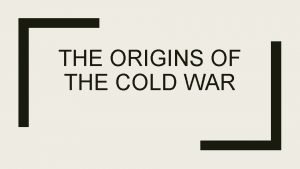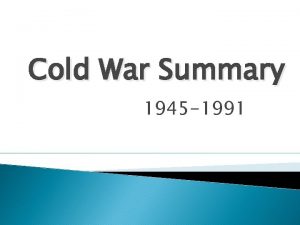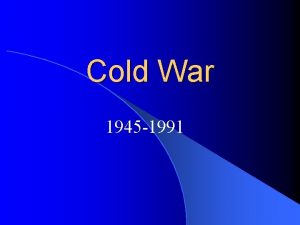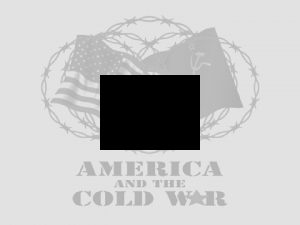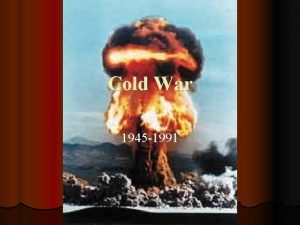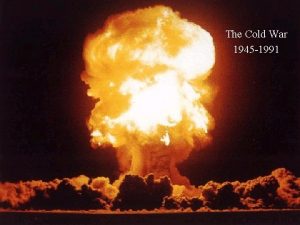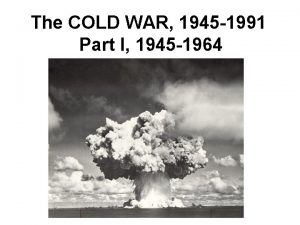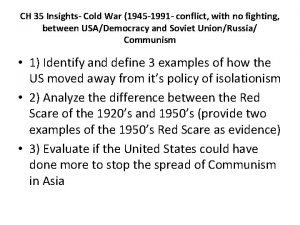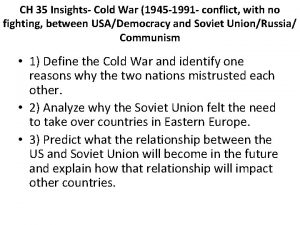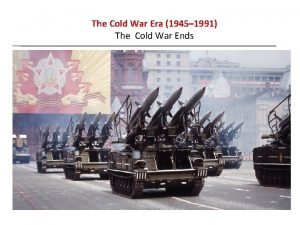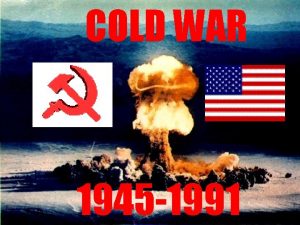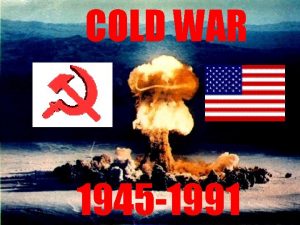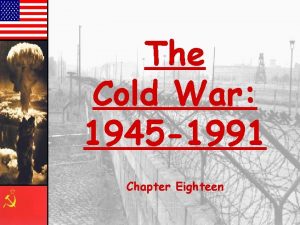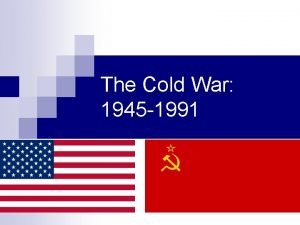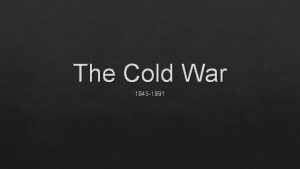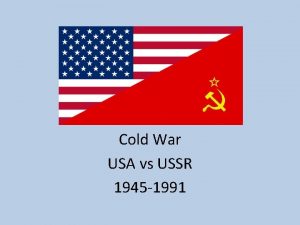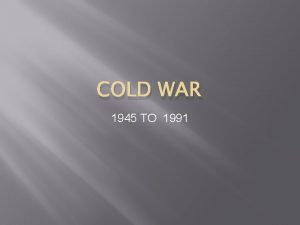The Cold War 1945 1991 Indirect conflict after


















- Slides: 18

The Cold War 1945 -1991 Indirect conflict after WW 2 Division of Germany and Berlin Constant threat of nuclear war Covert Conflicts, Coup d’etats, and Espionage Race to gain allies Race to space


Clash of Viewpoints United States Capitalist- private ownership, individuals own businesses Democracy Individualism Allies: Western Europe and any other capitalist countries Soviet Union (USSR) Communist- government controls economy Totalitarian Dictatorship Collective good of the country Allies: Eastern Europe, China, Cuba, and parts of Asia


1950 s Red Scare in U. S. Korean War – United States tried to stop communism in Korea CIA vs. KGB Mc. Carthyism


Images of 1950 s


Education in the 1950 s-60 s Sputnik creates a massive scare U. S. falls behind Soviets in Math and Science Government increases spending on education Scholarship opportunities increase

1960 s Cuban Missile Crisis. U. S. on brink of nuclear with USSR Space Race Vietnam War- U. S. tried to stop communism from spreading in Vietnam

1970 s Mutually Assured Destruction United States opens trade in China Vietnam fell to communists Treaties reduce nuclear weapons

Collapse of Communism- Eastern Europe and Soviet Union 1980 s Soviet Union and Eastern Europe Communist economies struggled Soviet Union’s invasion of Afghanistan failed Numerous protests Eastern Europe pushes for independence 1989 Fall of Berlin Wall

Communism Falls in Eastern Europe East and West Germany reunite Hungary and Poland become independent as result of Solidarity Movement Czechoslovakia splits into Czech Republic and Slovakia Romania, Bulgaria, and Albania move towards democracy Yugoslavia splits into 6 countries- Civil War and Ethnic Cleansing

1980 s China Deng Xiaoping 4 Modernizations. Agriculture, Military, Industry, and Technology Economic Improvements But no political freedom- still communist

Tiananmen Square Protest June 5 th 1989 Student Protests Wanted Political Freedom Government responds harshly- communism does not end “Deng’s Deal with the people”

1990 s Gorbachev’s reforms - Glasnost and Perestroika August Coup Fails Soviet Union Collapsescommunism ends Yeltsin elected president

Map of Soviet Union Collapse

Cold War Ends
 The cold war lesson 1 the cold war begins
The cold war lesson 1 the cold war begins The cold war begins 1945-1960
The cold war begins 1945-1960 The cold war heats up: 1945 - 1969
The cold war heats up: 1945 - 1969 The cold war heats up chapter 26 section 2
The cold war heats up chapter 26 section 2 Mania acronym for causes of wwi
Mania acronym for causes of wwi Chapter 33 section 4 foreign policy after the cold war
Chapter 33 section 4 foreign policy after the cold war Proxy war cold war definition
Proxy war cold war definition After me after me after me
After me after me after me John 14:1
John 14:1 1945 world war ii
1945 world war ii 1945 world war
1945 world war Primatic cylinder
Primatic cylinder Indirect cold water system
Indirect cold water system Cold war acrostic poem
Cold war acrostic poem Operation rolling thunder cold war
Operation rolling thunder cold war Postrevisionist
Postrevisionist Iron curtain political cartoon answers
Iron curtain political cartoon answers Operation rolling thunder cold war
Operation rolling thunder cold war The causes of cold war
The causes of cold war

